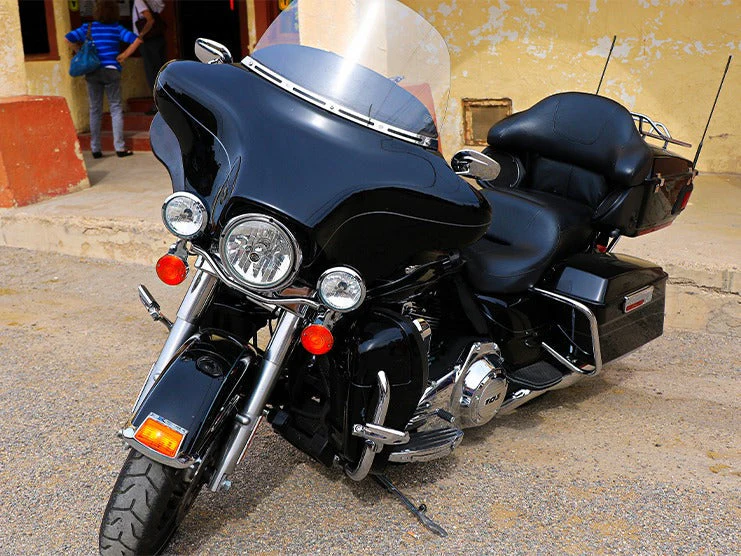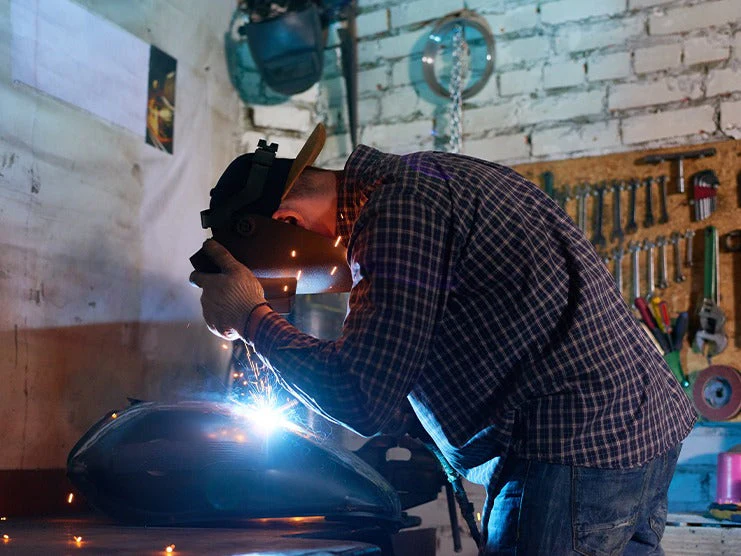Table of Content
Motorcycle fairings were first used during the early 1900s when the focus was to make motorcycles streamlined. Today, motorcycle fairing is used to improve performance, comfort, and looks. A motorcycle fairing is similar to a windshield but offers more benefits than the latter.
Unfortunately, not all motorcycles feature a fairing despite its usefulness. Sports bikes and luxury touring motorcycles come with a built-in fairing, but lightweight cruisers and street motorcycles must be fitted with a custom or aftermarket fairing. This article explains why you need a fairing and how it can improve your bike’s performance, range, stability, styling, and comfort.
1. Types of Motorcycle Fairing
Back in the 1950s, a large dustbin fairing that looked like an aircraft’s nose covered the motorcycle frame. The dustbin fairing was banned for safety reasons and replaced by the dolphin fairing. This massive fairing helped make the bike more streamlined but made handling more dangerous in crosswinds and high-speed cornering. Over the years, fairings have evolved into the following types
-
Full Fairing
A full fairing covers most of the frame and provides maximum protection from the wind, debris, and rain. Adding small winglets to a full fairing can improve the engine’s power output no matter the size of your bike’s motor. Large full fairings cover the upper and lower parts of the bike. -
Half Fairing
The half fairing shields the upper parts of the bike but offers no protection to the lower parts. If you are riding in the rain with a half-faired motorcycle, your lower legs and feet will get soaked. Unlike the full fairing, the half fairing allows optimal airflow that keeps riders cool on hot days. The half fairing offers the same aerodynamics as a full fairing. -
Quarter Fairing
A quarter fairing comes as a standard feature often fitted on most touring motorcycles. A quarter fairing is mostly used for aesthetics as they offer minimal wind protection. They are restricted to the headlight and the middle area of the handlebars, which means your hands will be exposed to the wind. It offers less comfort than the half and full fairings. -
Handlebar Fairing
Much like the quarter fairings, a handlebar fairing offers less wind protection and reduces fuel economy. It does not shield you or your bike’s lower area from the wind but is a great accessory if you mount a cell phone, GPS, camera, or other gadgets behind the handlebars.
2. Wind & Rain Deflection
A motorcycle fairing’s primary function is to deflect incoming winds. If you ride without a fairing, you be deprived of the following benefits.
-
Protection in Damp Conditions
During long-distance trips, it is not uncommon for riders to suddenly find themselves caught in the rain. A motorcycle fairing deflects the rain and keeps your helmet visor dry, ensuring you can spot other vehicles from a good distance and navigate safely.
-
Noise Reduction
When riding at speeds over 65 mph, strong winds batter your helmet and create a deafening noise. By deflecting wind, a motorcycle fairing greatly reduces the sound of the wind, ensuring a quieter riding experience and increasing your awareness. -
Reduced Fatigue
Besides reducing noise, wide and tall fairings divert air above your head. When riding between 70-80 mph, your body constantly being battered can cause you to become worn down. Many riders cannot enjoy the bike’s relaxed ergonomics as they are forced to bend forward to avoid the wind.
With a fairing, you don’t have to hunch over to avoid the wind. With less wind coming at you, you can maintain a comfortable riding posture while traveling long distances. With your back and neck muscles relaxed, you will not feel as tired, need to take many breaks, and will reach your destination faster. -
Protection from Chill and Dehydration
By deflecting wind, the fairing can keep your body from becoming cold or overheating. Body heat transfers from parts with higher temperatures to parts with lower temperatures. When cold wind hits the body, heat is lost due to evaporation and sweating. As the cold wind continues to lower the body’s temperature, the risk of wind-induced hypothermia and frostbite increase. On the other hand, if you are riding in hot weather, the lack of wind may cause your body to become dehydrated and exhausted. A motorcycle fairing controls the flow of incoming wind to ensure your body stays cool. It also acts as a shield for your hands, keeping them dry, warm, or cool depending on the weather conditions.
3. Protection from Debris
Any random pieces scattered on the road are considered debris. Improperly loaded trucks, inadequate road maintenance, pieces of a damaged vehicle, and unethical road construction practices are causes of road debris. Moreover, roads in regions that receive little rain often don’t have more road debris, such as metal debris, dry leaves, and stones.
It is easier to swerve out of the way of incoming road debris, but not all debris is visible. Small gravel, fragments of glass, and construction material can cause injuries, and lead to accidents. Though state governments are responsible for keeping roads clean, you cannot expect all roads to be safe. Make sure your motorcycle is equipped with a fairing to shield you from flying debris.
4. Improved Aerodynamics
Modern fairings can help improve aerodynamics. Motorcycle aerodynamics is the movement of the wind around the bike. When air makes contact with a motorcycle without a fairing, the wide handlebars and the rider’s body will cause the air to flow around a large surface area. On the other hand, a fairing reduces the surface area, allowing the air to flow around the bike more quickly.
-
Winglets for Downforce
By adding internal winglets at the front, this will create a downforce around the front wheel, fork, center around the engine, and rear end. To create this downforce, ride at high speeds. The greater the speed, the greater the downforce. This will ensure your bike remains stable, keeps the wheels on the ground, and improves acceleration. Make sure to choose a fairing with smaller winglets; otherwise, it will create more drag at high speeds.
It is worth mentioning that drag isn’t always bad. If a lot of drag is exerted on the fairing winglet, it can act as an air brake and improve your motorcycle’s braking power. Moreover, drag created by large downforce and high acceleration improves traction, stability, and cornering. If you want, you can remove the winglets to eliminate drag completely and enjoy faster acceleration. -
Reduced Air Drag & Engine Life
By improving aerodynamics, a motorcycle fairing reduces air drag, especially if the winglets are not mounted on the fairing. Due to having larger surface areas, motorcycles without motorcycles create more drag. Since motorcycle fairings decrease the front surface area, they decrease drag significantly.
The reduced drag means you can quickly accelerate to high speeds at low rpm ranges. This can improve engine efficiency, lifespan, and fuel economy. This increases your range, allowing you to cover more miles on a full gas tank. You will also not have to refuel or maintain the engine as frequently since you will be able to cover long distances in less time.
5. Lower Fairings for Leg Protection
Lower fairings are mounted on the engine guard to adjust incoming airflow. These fairings also regulate the temperature of the engine, keeping it cool as you ride at high speeds.
Lower fairings are crucial for leg protection in the event of an accident. According to a study published by Motorcycle Minds.org, a well-designed lower fairing provides substantial protection during a “critical impact period” - the moment when a high-speed crash occurs. This motorcycle safety study also claims that a lower fairing will decrease the severity of leg injuries and fractures. Only 28.3% of riders riding a motorcycle with a fairing suffered leg injuries, while 33.6% of riders riding a motorcycle without a fairing suffered leg injuries.
Furthermore, only 14.2% of the total riders riding motorcycles with a fairing suffered fractures, while 23% of riders riding motorcycles without fairings suffered fractures. The study also claims that a standard front failing can also provide leg protection during a collision.
6. Protects Bike During a Crash
In a crash, a motorcycle fairing protects the rider and motorcycle parts. A fairing is the first thing that comes in contact with the other vehicle during a collision. By absorbing the impact, it protects the motorcycle’s frame and other components. Lower fairings are mounted near the engine and if your motorcycle tips over, it will act as a barrier protecting the engine from hitting the ground.
7. Improved Styling
A motorcycle fairing can be a stylish accessory that improves your bike’s overall styling. For example, a full fairing gives your bike a bagger look. Adding a fairing on a bobber or naked motorcycle gives the bike an aggressive sporty look.
A fairing is used to customize the bike and be customized itself. You can change the paint on aftermarket fairings or add stylish graphics and unique stickers to stock fairings. You can get your fairings custom-made with different colors and illustrations on them. A custom fairing can add a personal touch to your bike.
8. Protects Accessories
For highway rides, motorcycle camping trips, and city explorations, it helps to have a GPS, cell phone mount, WiFi Hotspot, and cup holders. All of these accessories are mounted at the front of the bike. Some riders also like to mount a camera on the handlebars to film their road trips. A motorcycle fairing shields these gadgets from the wind, rain, and other hazards. By reflecting sunlight, it also improves the visibility of the display screens of these devices.
9. Takeaway
motorcycle fairing is a versatile part that improves aesthetics, protection, mileage, and riding quality. Riders who prefer to ride without a fairing or windshield put their safety at risk. There is a certain charm to riding a naked bike and feeling the wind on your face and in your hair. However, once you ride a faired motorcycle, you will never want to ride without one. If you want to test your bike’s performance, then mount a fairing before hitting the roads.













Leave a comment
All comments are moderated before being published.
This site is protected by hCaptcha and the hCaptcha Privacy Policy and Terms of Service apply.